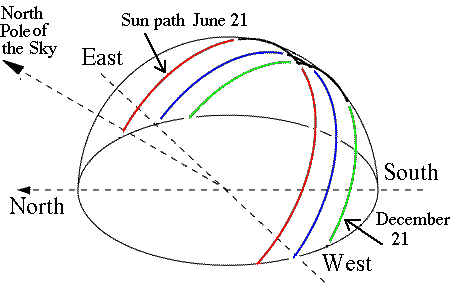The December solstice, shortest day of the year is today, December 21. At approximately 12:47 p.m. EST (1747 UTC), the Sun’s apparent motion in the sky will come to a standstill (Latin, solstitium).* That’s because it has finished its southward migration for the year, and from here until June old Sol will travel north. And as it does so, days in the northern hemisphere will get longer. The image below, from an excellent NASA website, shows the paths of the sun on the longest and shortest days of the year:

Down here in South Florida, the contrast between the longest and shortest days of the year isn’t really all that great–almost exactly three hours. Travel north to Boston, though, and you get a very different picture: twice as much “extra” daylight. The table below shows the five “daylight” markers from the USNO for December 21, 2009, and the next solstice, June 21, 2010, in Boca Raton and Boston. (December times are EST; June times are EDT):
[table “” not found /]Boca gets an extra hour of sunlight in winter compared to Boston; what we gain in December, though, we pay back with interest in June: Boston’s longest day is nearly two hours longer than Boca’s. If you’re interested in other astronomical events for this past year, or next year, click the links.
Another thing you can infer from the data in the table: Boca is well to the west of Boston. Solar transit is much earlier in beantown than South Beach. (Yes, Boca has a South Beach; it’s just not That South Beach.)
The solstice marks the beginning of the return of the sun; many cultures celebrated its arrival with pageantry and celebration. Our current celebration here in the western hemisphere involved bringing a fresh-cut or live pine tree into the house, decorating and lighting it lavishly, and hoping that one’s house doesn’t catch fire. Those of us who really want to risk a flaming catastrophe put much of our annual earned income, represented by colorfully wrapped boxes, near the potential conflagration, in hopes of heightening the pleasure of giving and receiving by the relief at having, once again, escaped with our lives. Is it any wonder that this event takes place near the longest night of the year?


Happy Solstice!
I’m curious about the * by solstitium. Is there a missing footnote?
Thanks for the etymology lesson as always.
@Oroboros: aargh! Of course there’s a missing footnote. I had scheduled this post months ago, and built it all very carefully, and then for the first and only time ever (so far), my blogging software didn’t post as scheduled. And in the cut and paste fiasco, the footnote dropped out. Solstitium is built from Sol, sun, and sistere, to stand still. Around the solstice, the sun appears to stand still in its motion against the background stars, while it begins its apparent journey in the opposite direction. I had also meant to link to a nice site explaining more about the solstice, but can’t find it right now. Here’s a decent one about the June solstice, though.
Thanks for the clarification. I had 3 years of Latin in high school, but sistere had been lost to the ravages of time.
One thing I like to do is to use the last rays of the setting sun to light a fire for the longest night. I have a very old magnifying glass that belonged to grandfather that I like to use for this purpose (though I often cheat by pointing it at a wooden kitchen match and then just lighting a candle from that).
Some day I’ll have to try making a real fire from an ice lens. I often spend winter solstice at a friend’s hut in the mountains, but it didn’t work out this year. That would be the place to do it.